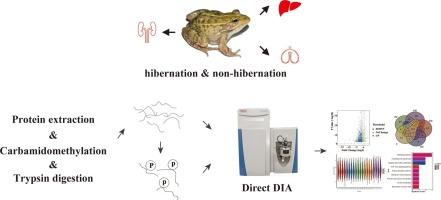Deciphering multi-organ protein regulatory strategies in the Asian frog, Pelophylax nigromaculatus during hibernation to elucidate energy homeostasis maintenance mechanisms
IF 2.2
2区 生物学
Q4 BIOCHEMISTRY & MOLECULAR BIOLOGY
Comparative Biochemistry and Physiology D-Genomics & Proteomics
Pub Date : 2025-08-08
DOI:10.1016/j.cbd.2025.101602
引用次数: 0
Abstract
Hibernation is a low-energy consumption survival strategy adopted by organisms to cope with adverse environments such as low temperatures and food scarcity. This study used the Pelophylax nigromaculatus as the model organism, and for the first time comprehensively analyzed the proteomic and phosphoproteomic regulatory networks in its kidneys, liver, and lungs through DIA quantitative proteomics technology, revealing specialized organ protection mechanisms under the hypometabolic state of hibernation. The research found that the regulation of these proteins relates to glycolysis and glycogenolysis, enhanced intracellular substance transport, membrane repair and energy buffering, rapid degradation of glycation end products, mitigation of inflammatory responses, and maintenance of signal transduction and cellular morphology. Using the glycogenolysis inhibitor CP-91149 to block glycogen breakdown, the study investigated frog hibernation status when glycogenolysis was inhibited to a certain extent, with results showing these frogs exhibited higher mortality during hibernation. This research not only provides substantial reliable data for elucidating the molecular mechanisms of amphibian hibernation but also establishes a foundational framework for understanding the molecular regulation of animal low-energy metabolism.

破译亚洲蛙在冬眠期间的多器官蛋白质调控策略,阐明能量稳态维持机制
冬眠是生物为应对低温、食物匮乏等不利环境而采取的一种低能量消耗的生存策略。本研究以黑斑痣Pelophylax nigromaculatus为模式生物,首次通过DIA定量蛋白质组学技术全面分析了其肾、肝、肺的蛋白质组学和磷酸化蛋白质组学调控网络,揭示了冬眠低代谢状态下的特化器官保护机制。研究发现,这些蛋白的调控与糖酵解和糖原溶解、增强细胞内物质运输、膜修复和能量缓冲、糖基化终产物的快速降解、炎症反应的缓解以及信号转导和细胞形态的维持有关。本研究利用糖原分解抑制剂CP-91149阻断糖原分解,研究了糖原分解受到一定程度抑制时蛙类的冬眠状态,结果表明蛙类在冬眠期间死亡率较高。本研究不仅为阐明两栖动物冬眠的分子机制提供了大量可靠的数据,而且为理解动物低能量代谢的分子调控建立了基础框架。
本文章由计算机程序翻译,如有差异,请以英文原文为准。
求助全文
约1分钟内获得全文
求助全文
来源期刊
CiteScore
5.10
自引率
3.30%
发文量
69
审稿时长
33 days
期刊介绍:
Comparative Biochemistry & Physiology (CBP) publishes papers in comparative, environmental and evolutionary physiology.
Part D: Genomics and Proteomics (CBPD), focuses on “omics” approaches to physiology, including comparative and functional genomics, metagenomics, transcriptomics, proteomics, metabolomics, and lipidomics. Most studies employ “omics” and/or system biology to test specific hypotheses about molecular and biochemical mechanisms underlying physiological responses to the environment. We encourage papers that address fundamental questions in comparative physiology and biochemistry rather than studies with a focus that is purely technical, methodological or descriptive in nature.

 求助内容:
求助内容: 应助结果提醒方式:
应助结果提醒方式:


